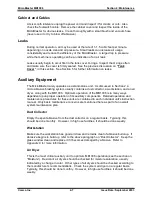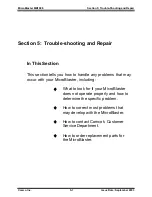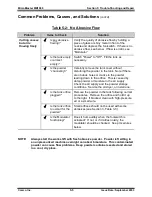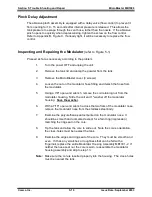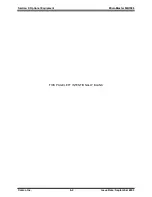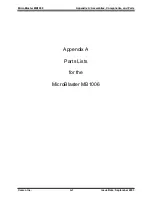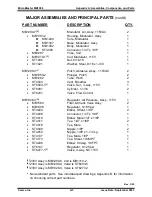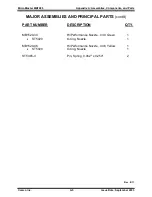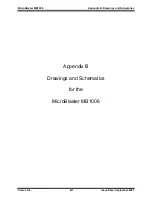
MicroBlaster MB1006
Section 5: Trouble-Shooting and Repair
Comco Inc.
5-13
Issue Date: September 2003
Clogging
Moisture or particulate matter contamination in the abrasive powder can cause clogging
problems in your MicroBlaster. The most likely place for clogging to occur is in the tank
orifice. Provided the orifice is sized properly for the type of abrasive being used (see
Section 3, “Orifice Selection”), the powder should always flow freely from the tank.
Since the tank orifice is the only way for the powder to get from the tank to the mixing
chamber, a clog here restricts or prevents powder flow. If air is flowing freely when the
footswitch is depressed but there seems to be no abrasive in the air stream, check the
tank orifice (see Section 3, “Changing the Tank Orifice”), remove it, clean if necessary.
Observe for signs of moisture or particulate contamination.
Nozzle
If the unit is pressurizing and you can see the pinch opening when the footswitch is
depressed, but no air is flowing from the nozzle, the nozzle is probably plugged. The
most likely cause of this is an oversized tank orifice. Too much powder in the air stream
can overload the nozzle and cause clogging (see Section 3, Orifice/Nozzle selection).
Remove the nozzle. Check it by holding the tip to a light. A point of light should be
visible through the tip. Tap it on the workbench, back end down, to release the clog.
Discard the nozzle if it remains plugged.
If plugging recurs, either the tank is releasing too much powder or the nozzle is too small
for the powder.
Leaks
Small leaks can increase air usage considerably and reduce the efficiency of the
MicroBlaster. A large drop in pressure while the machine is operating can be an
indication of an air leak. Check the supply air inlet hose and the supply regulator for
leaks. This is a high-pressure line so small leaks can cause the loss of large volumes of
air.
If a leak is suspected within the MicroBlaster, switch off the power and remove the
cabinet cover. Are there any noticeable powder clouds or unusual powder buildup inside
the machine? This is an indication of a leak in the abrasive or vent lines. Check for
loose hose connections.
If necessary, switch the power on to re-pressurize the unit. Are there any noticeable or
audible leaks? Listen near the tank top, pinch, tank vent hose and pressure regulator; or
apply a soap solution to these locations and watch for bubbles.
CAUTION: There is High Voltage at the Terminal Block!!
Note:
It is very hard to detect a slight leak in the tank cover. If you cannot locate a leak
anywhere else, it is probably the tank cover O-rings. See the following
discussion,
“Tank Cover”.
Summary of Contents for MicroBlaster MB1006
Page 10: ......

